We all struggle with managing all of our passwords. Every site and account wants a password, and some make you change them regularly. Keeping track of all these passwords has become quite a chore, so many people use easy-to-remember passwords or re-use passwords to make that chore simpler. The problem is that doing that makes it easy to guess or hack your passwords.
What to do? Before jumping into how to manage all these passwords, let’s go over some rules to keep in mind when creating passwords.
Password Rules
- Never reuse a password. This means that every account you have should have its own password. Why? If a someone gets a password you’ve reused, they can gain access to other accounts that share that same password.
- Don’t use simple words from the dictionary as passwords. Words like
fishing, oraccountant, or worst of all,passwordare all terrible passwords. Even variations using numbers, such asf1sh1ng, oracc0untantare equally bad. The bad guys have long lists of dictionary words and similar variations. - Don’t use pet names, spouse names, your city, etc. These are often easy for hackers to find through social media and other online sources.
- Do create strong passwords. Use either a long string of numbers, letters (both upper and lower case) and symbols, or a series of unrelated words that might be easier to remember. Some examples:
rfFbYTCxFPgudPEJTP^E9im, orFreezer-horseshoe-Forested-64. In both cases, the passwords are long, not a simple word, and very hard to guess. You may think that the second one breaks the rules because it is made up of dictionary words. But, the difference is that there are several words that are unrelated. A hacker’s list of words from a dictionary would not contain this set of words together in this way.
It may seem challenging to come up with good passwords. You’ll see below that you can let your iPhone or iPad handle that for you.
Little Black Book?
Now that we have some ground rules, we need to address the other major issue: keeping track of all these passwords. Even if you try to make passwords that you can remember, after a while, the list is just too long to manage. I know many of you have a little black book that contains all your passwords. I think here is a better way: using your iPhone or iPad as your little black book. You get the benefit of always having your passwords with you, automatic strong password creation, safe and secure backups, and best of all, automatic password entry! And, it’s already built into your device.
Setting Up
Setting this is up is pretty simple. You need to have a passcode on your device, and ensure that iCloud Keychain is turned on.
- If you don’t have a passcode set, go to Settings and find Touch ID & Passcode or Face ID & Passcode (depends on which device you have). Once there, tap Turn on Passcode and create a passcode. NOTE: You will need to enter this passcode each time you use your device, so be sure to use something you’ll remember.
- Optionally, turn on Touch ID or Face ID. These features make it very simple to use your device as well as to get to your passwords. Both features are highly secure, and your fingerprint or face data never leaves your device.
- iCloud Keychain: This allows encrypted storage and backup of your passwords. It is highly secure, as all passwords are encrypted and only your device has the unlock key. Not even Apple can unlock your passwords.
- To verify iCloud Keychain is on (or to turn it on), go to Settings, and tap your name at the top of the list and then tap iCloud.
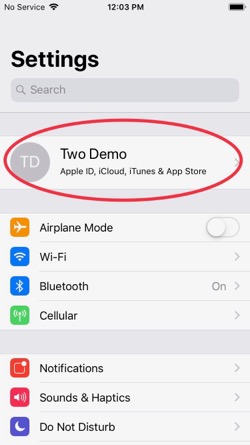

- Now, scroll down a bit and look for Keychain in the list. It will show either “off” or “on”. If it is off, tap it and follow the instructions to turn it on.

The last thing to check is that your device is set to auto fill passwords. Go back to the main Settings page and tap Passwords & Accounts, and then ensure AutoFill Passwords is turned on.


Saving Passwords
Now that you have this set up, your device will keep track of passwords for you. If you browse to a site that asks for a user name and password, after you enter them, you will be prompted to save. For example, if you go to costco.com, you’ll see a page such as this:

Once you enter your email address and password, your device will ask you this:
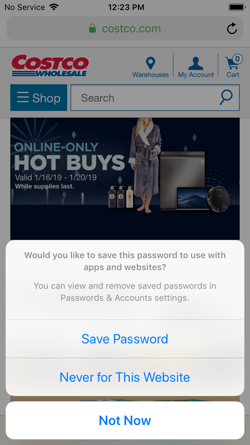
Just tap Save Password and your device will remember it for the future. Easy!
Using Passwords
Once a password has been saved, the next time you visit that site, your device will ask you if you’d like to use the saved password. So, if you’ve saved your amazon.com password, and then browse to amazon.com you’ll see:

Notice at the bottom of the screen that you’re asked if you’d like to log in using a saved user name? Tap the blue button, and it will ask you to verify your identity, either with your passcode or your Touch ID (if you have Face ID, it will automatically scan your face).

Once that’s done, it will automatically fill in your user name and password and you’re ready to go:

Sometimes you’ll see the account right above the keyboard as shown here. Tap that and it works in the same way.

Finding Passwords
There will be times when you’ll need to look up your passwords. Say you’re sitting at your PC and need one of your passwords. Instead of reaching for your little black book, you can reach for your phone and easily find it. To find a password, go to Settings and tap Passwords & Accounts:


The first item on that page is Website & App Passwords. Tap that and you’ll be asked to verify your identity with either your passcode or Touch ID/Face ID. When you do, you’ll see your list of passwords:
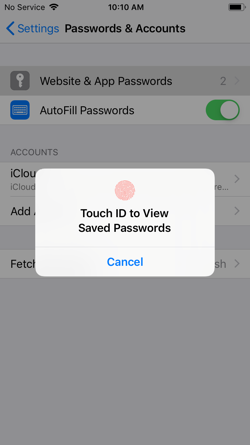

Tap on an entry to see the user name and password. You can search for a password using the search box at the top. You can tap and hold on any of these items to copy them. And you can tap Edit at the top of the screen to delete items or change their information.
Tip: Use Siri!
Siri makes it even easier to find your passwords. Either press and hold your home button or say “Hey Siri” and then ask to see a specific password. For example, you can say “Hey Siri, show my amazon.com password.” Siri will ask you to verify your identity (passcode or Touch ID) and then your password will be shown on the screen.
Creating New Passwords
You now have the basics of saving and using your passwords, but what about creating a new one? There are two situations where you’ll want to create a new password to save to your list.
New Account
When creating a new account at a web site, your device will offer to create a new, strong password for you and then automatically save it. This is a great way to ensure you always have good passwords and that they are saved and ready to be used again. Better yet, you don’t have to try to think of a good password on the spot.
As an example, let’s say you are creating a new account at costco.com. You’d see this page:

Once you fill in the email address field and move to the password field, your device will automatically create and fill-in a new, strong password:
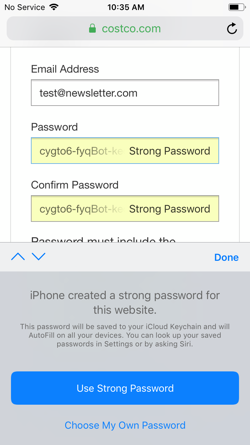
Simply tap Use Strong Password and your device will save that password for this account. You can now continue through the site’s account creation.
The next time you visit this site and need to log in, your password will be automatically filled in for you as shown above.
New Entry
You might also want to just add a password to your list directly. To do that, go to Settings and tap Passwords & Accounts, then tap Website & App Passwords. (You can also ask Siri to “create a new password”).


You’ll be asked to verify your identity (passcode or Touch ID/Face ID) and you will then be taken to your password list. Tap the + button at the top right, then fill out the fields in the form that appears:


Tap Done when you’re finished and the new entry will be saved to your list.
Bonus: Passwords in Apps
In all the examples above, I use web sites to show how these password features work. But, they will also work in most apps. So, if you install an app that needs your password (or you’re creating an account), you can use the same features as described above. For example, if you install the Twitter app, when it asks you to log in, just tap Passwords above the keyboard as shown here:

Passwords Managed!
I hope you’ve found this article useful. Managing your passwords can be simpler by using the techniques covered above.
If you have any questions about anything in this article, or if there are specific topics you’d like me cover in the future, just let me know.
Links
If you are interested in more details on some of the information above, here are some links.
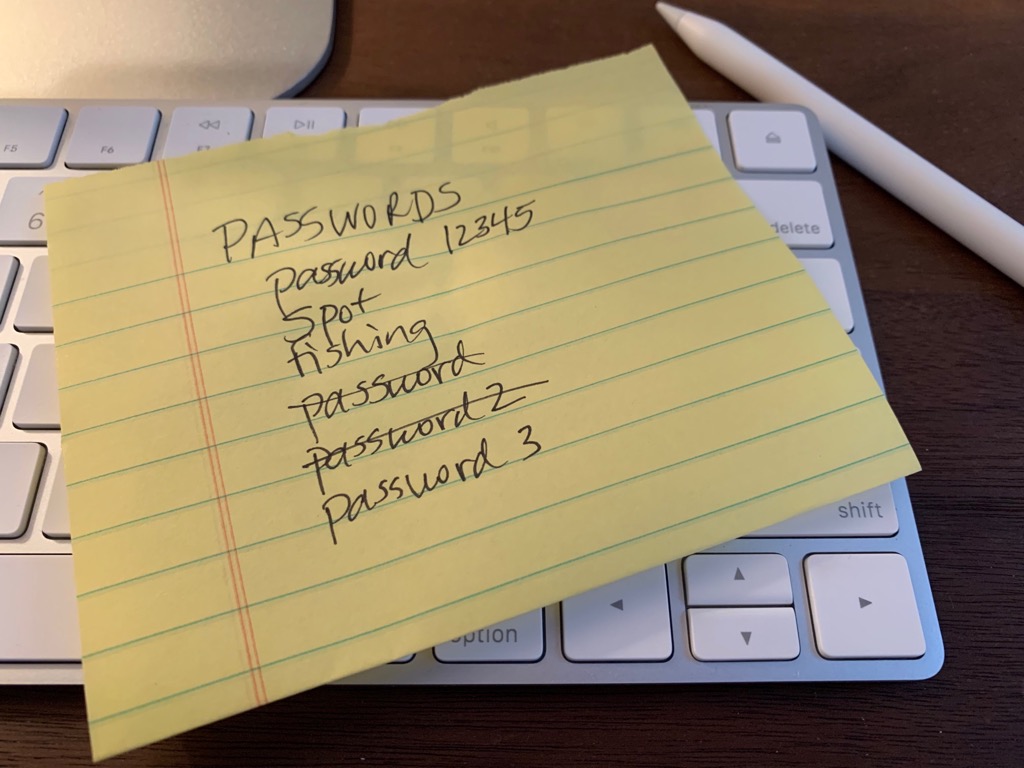

Rob,
This is really great information for us that do not realize how important and easy it is for other people to get account information on all of us. May times near the end of my career I spoke to people who were victimized by hackers and thieves, it causes so much damage to financial accounts, but more importantly ones stress and well being. I am very happy you are doing this project and you can count on us to pass along to our friends as well.
Well done!
Kevin and Angie
LikeLike
Thank you! I appreciate that.
LikeLike